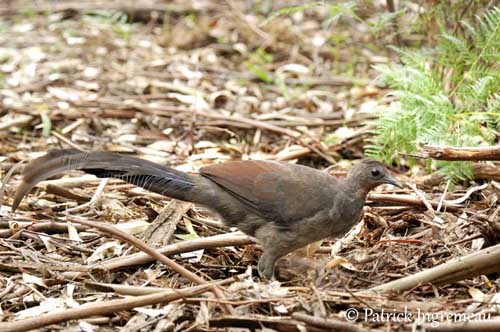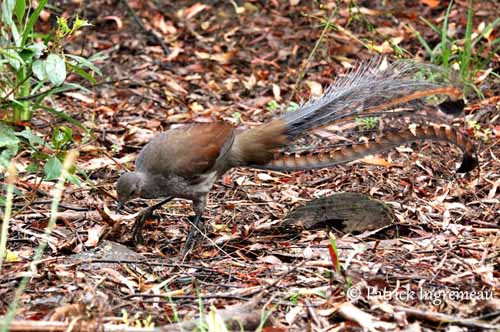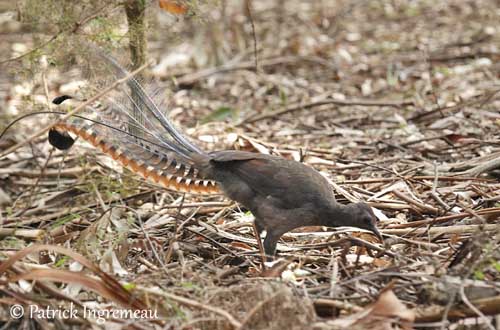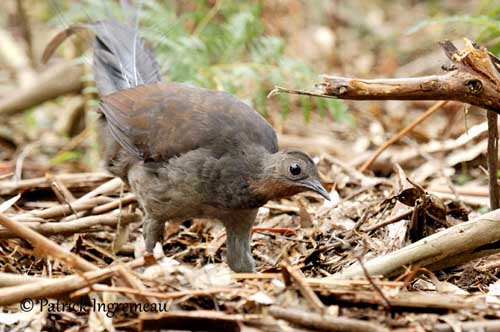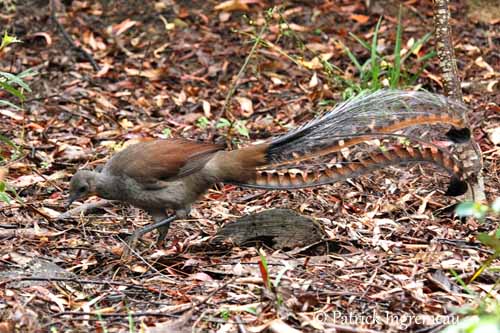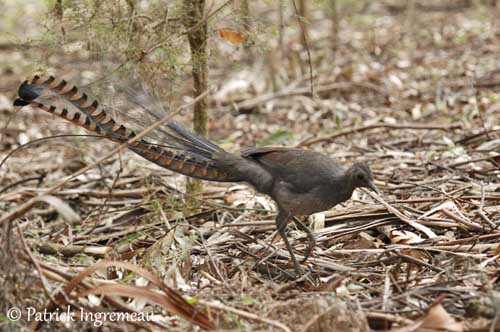
Superb Lyrebird
Menura novaehollandiae
Passeriforme Order - Menuridae Family
BIOMETRICS: Length: 80- 98 cm; Weight: 975 g
PHYSICAL DESCRIPTION:
Superb Lyrebird was discovered by John Wilson in 1788. It is endemic to Australia.
Adult male has brown body plumage, except on tail. Upperparts are rather dark brown, with greyish-brown mantel. Underparts are paler and greyish. We can see red to brown markings on throat. Wings are rufous-coloured.
Long tail (up to 50-60cm in male) shows two external long curved feathers, named “lyrates”. Theses two feathers are buff-white, regularly barred with chestnut. The other tail feathers show lacy appearance. There are seven pairs of feathers, with longer central pair. They are named “filamentaries”.
Female is smaller (74 to 84 cm). She has shorter, more pointed tail, and she lacks the lacy feathers.
Juvenile resembles female.
We can find other similar species living in Australia: the Albert’s Lyrebird (Menura alberti). It is redder in colour, with less elaborate long tail.
VOICE: SOUNDS BY XENO-CANTO
Superb Lyrebird’s song includes about 80% of mimicries. It has wide vocal range and produces strange sounds such as car-engines, dog’s barks and songs of other species. Male is talented songbird, and can utter powerful, far-carrying and lyrical songs. It also utters series of whistles and cackling notes as territorial calls, and loud shrieks as alarm calls.
Female utters quieter calls.
HABITAT:
Superb Lyrebird lives in wooded areas and moist forests.
RANGE:
Superb Lyrebird is found in eastern Australia, from southern Queensland to Victoria. It has been successfully introduced in Tasmania.
BEHAVIOUR:
Superb Lyrebird is shy and wary, and hard to seen, but its powerful song reveals its presence. It runs and dodges through the dense undergrowth. They roost in trees.
It searches for food on the ground, raking over leaf litter with its strong feet.
It usually forages alone, but females and young males may feed together.
In the early winter, males secure “arenas” within territories for their displays, in order to attract females. Displays consist in songs and dances. Songs are elaborated, with rich and powerful notes mixed with mimicries of other bird species.
Dances occur on mounds situated within territories. These mounds are made with mud by males. Then, they stand onto these mounds to be better seen by females. Males throw the tail forwards over back, and shake their long feathers, producing vibrations along the lacy feathers and the lyrates. At this moment, tail appears as wide vibrating fan. Usually, one male will mate with several females.
FLIGHT:
Superb Lyrebird can fly, but it flies rarely, only for gliding back down from mound or low branch.
Its wings help it in running and jumping up into branches in trees, and onto rocks. It flies heavily, and proceeds upwards by series of wing beats.
REPRODUCTION:
Breeding season occurs from April to October and from May to August in northern parts of the range.
After mating, female builds a nest with sticks, leaves and twigs woven together in order to form large dome-shaped nest. Nest may be on the ground, or elevated in stump, or ferns, or in trees, up to 25 metres above the ground.
Male is polygamous and does not take any part in nesting duties.
Female lays only one grey to purple-brown egg, with dark grey markings. Incubation lasts about six weeks. Chick is covered with white down. It leaves the nest about six to ten weeks after hatching, but it still depends of female for 7 or 8 months more.
Young male reaches its sexual maturity at about 7 to 9 years, and female at 6 to 7 years.
DIET:
Superb Lyrebird feeds on worms, insects, spiders and sometimes seeds. It feeds at ground level, and finds its food in leaf-litter.
PROTECTION / THREATS / STATUS:
Superb Lyrebird is widespread and common in its range and not considered as threatened.
It was killed in the 19th century for its tail feathers, and numerous birds were shot in these years. It is now protected by laws.
Fr : Ménure superbe
All : Graurücken-Leierschwanz
Esp : Ave-lira Soberbia
Ital : Uccello lira superbo
Nd : Liervogel
Russe : Большая птица-лира
Photos de Patrick Ingremeau
TAMANDUA
Texte de Nicole Bouglouan
Sources :
HANDBOOK OF THE BIRDS OF THE WORLD Vol 9 - by Josep del Hoyo - Andrew Elliot - David Christie - Lynx Edicions - ISBN: 8487334695
L’ENCYCLOPEDIE MONDIALE DES OISEAUX - Dr Christopher M. Perrins - BORDAS - ISBN: 2040185607
Arthur Grosset's Birds (Arthur Grosset)
Birds in backyards (Birds Australia and Australian Museum)
CREAGUS@Monterey Bay (Don Roberson)
Wikipedia (Wikipedia, The Free Encyclopedia)


